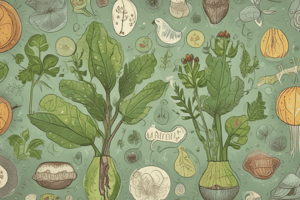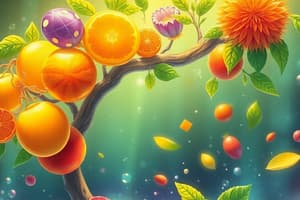Podcast
Questions and Answers
What is the primary product formed during photosynthesis as a result of the absorption of sunlight by chlorophyll?
What is the primary product formed during photosynthesis as a result of the absorption of sunlight by chlorophyll?
- Carbon Dioxide
- Water
- Glucose (correct)
- Oxygen
Monosaccharides are composed of multiple sugar units.
Monosaccharides are composed of multiple sugar units.
False (B)
Name one source of fructose.
Name one source of fructose.
Fruit
Carbohydrates are classified into three main groups: _____, Disaccharides, and Polysaccharides.
Carbohydrates are classified into three main groups: _____, Disaccharides, and Polysaccharides.
Match the following carbohydrate types with their characteristics:
Match the following carbohydrate types with their characteristics:
Which of the following is a disaccharide found in milk?
Which of the following is a disaccharide found in milk?
Polysaccharides are composed of single monosaccharide units.
Polysaccharides are composed of single monosaccharide units.
Name one source of starch.
Name one source of starch.
The chemical formula for sucrose is ______.
The chemical formula for sucrose is ______.
Match the polysaccharide with its characteristic:
Match the polysaccharide with its characteristic:
Which type of fiber helps absorb fat and sugar from food sources?
Which type of fiber helps absorb fat and sugar from food sources?
All polysaccharides are soluble in water.
All polysaccharides are soluble in water.
What is the primary function of fiber in the diet?
What is the primary function of fiber in the diet?
What enzyme is responsible for the initial digestion of carbohydrates in the mouth?
What enzyme is responsible for the initial digestion of carbohydrates in the mouth?
Monosaccharides are absorbed through the villi of the stomach.
Monosaccharides are absorbed through the villi of the stomach.
What happens to waste that is left after the digestive processes?
What happens to waste that is left after the digestive processes?
_____ enzymes such as maltase, sucrase, and lactase are produced in the intestinal juice.
_____ enzymes such as maltase, sucrase, and lactase are produced in the intestinal juice.
Match the following terms with their descriptions:
Match the following terms with their descriptions:
What is the ideal sugar concentration for making jam?
What is the ideal sugar concentration for making jam?
Pectin extracted from overripe fruit is ideal for making jelly.
Pectin extracted from overripe fruit is ideal for making jelly.
What temperature should the fruit mixture be cooked to for proper jam consistency?
What temperature should the fruit mixture be cooked to for proper jam consistency?
The _____ chains of pectin form an interconnected mesh that creates the gel texture of jam.
The _____ chains of pectin form an interconnected mesh that creates the gel texture of jam.
Match the type of heat with its effect on carbohydrates:
Match the type of heat with its effect on carbohydrates:
What role do sugar molecules play in jam making?
What role do sugar molecules play in jam making?
Water evaporation during boiling increases the overall sugar concentration in jam.
Water evaporation during boiling increases the overall sugar concentration in jam.
In jam making, what happens when pectin is heated in the presence of acid?
In jam making, what happens when pectin is heated in the presence of acid?
Which of the following foods is considered low-GI?
Which of the following foods is considered low-GI?
Sugar intake should be limited to no more than 30g per day.
Sugar intake should be limited to no more than 30g per day.
What are two associated dietary disorders caused by excessive sugar and starch intake?
What are two associated dietary disorders caused by excessive sugar and starch intake?
Soluble fiber can be digested by the body and is broken down in the ______ by bacteria.
Soluble fiber can be digested by the body and is broken down in the ______ by bacteria.
Match the following types of fiber with their characteristics:
Match the following types of fiber with their characteristics:
Which of the following is NOT a low-GI fruit?
Which of the following is NOT a low-GI fruit?
What process breaks down carbohydrate chains into monosaccharides during digestion?
What process breaks down carbohydrate chains into monosaccharides during digestion?
Nuts are considered high-GI foods.
Nuts are considered high-GI foods.
What is the energy provided by 1 gram of carbohydrates?
What is the energy provided by 1 gram of carbohydrates?
A high glycemic index diet is based on foods that lead to stable blood sugar levels.
A high glycemic index diet is based on foods that lead to stable blood sugar levels.
What is the purpose of extracting pectin when making jam?
What is the purpose of extracting pectin when making jam?
Foods with a low glycemic index have a GI score of less than _____ .
Foods with a low glycemic index have a GI score of less than _____ .
Match the following GI categories with their corresponding example foods:
Match the following GI categories with their corresponding example foods:
What happens to excess carbohydrates in the body?
What happens to excess carbohydrates in the body?
The glycemic index uses white rice as a reference food.
The glycemic index uses white rice as a reference food.
Which type of fiber helps reduce LDL cholesterol?
Which type of fiber helps reduce LDL cholesterol?
Flashcards
Photosynthesis
Photosynthesis
Process where plants produce glucose (sugar) using sunlight, water, and carbon dioxide.
Monosaccharide
Monosaccharide
A simple sugar molecule containing one sugar unit, like glucose, fructose, or galactose.
C6H12O6
C6H12O6
The chemical formula for glucose, a simple sugar.
Chlorophyll
Chlorophyll
Signup and view all the flashcards
Disaccharide
Disaccharide
Signup and view all the flashcards
Sucrose
Sucrose
Signup and view all the flashcards
Maltose
Maltose
Signup and view all the flashcards
Lactose
Lactose
Signup and view all the flashcards
Cellulose
Cellulose
Signup and view all the flashcards
Starch
Starch
Signup and view all the flashcards
Glycogen
Glycogen
Signup and view all the flashcards
Pectin
Pectin
Signup and view all the flashcards
Pectin & Ripening
Pectin & Ripening
Signup and view all the flashcards
Acid in Jam Making
Acid in Jam Making
Signup and view all the flashcards
Sugar & Water Binding
Sugar & Water Binding
Signup and view all the flashcards
Boiling & Gel Formation
Boiling & Gel Formation
Signup and view all the flashcards
Jam Sugar Concentration
Jam Sugar Concentration
Signup and view all the flashcards
Dry Heat & Carbohydrates
Dry Heat & Carbohydrates
Signup and view all the flashcards
Moist Heat & Carbohydrates
Moist Heat & Carbohydrates
Signup and view all the flashcards
What are Carbohydrates?
What are Carbohydrates?
Signup and view all the flashcards
What are low-GI foods?
What are low-GI foods?
Signup and view all the flashcards
What is Glycemic Index (GI)?
What is Glycemic Index (GI)?
Signup and view all the flashcards
What is soluble fiber?
What is soluble fiber?
Signup and view all the flashcards
What is Insoluble Fiber?
What is Insoluble Fiber?
Signup and view all the flashcards
Maillard reaction
Maillard reaction
Signup and view all the flashcards
Pectin extraction
Pectin extraction
Signup and view all the flashcards
Starches and sugars
Starches and sugars
Signup and view all the flashcards
Soluble fiber
Soluble fiber
Signup and view all the flashcards
Insoluble fiber
Insoluble fiber
Signup and view all the flashcards
Glycemic Index (GI)
Glycemic Index (GI)
Signup and view all the flashcards
Low GI foods
Low GI foods
Signup and view all the flashcards
High GI foods
High GI foods
Signup and view all the flashcards
Digestion
Digestion
Signup and view all the flashcards
Salivary Amylase
Salivary Amylase
Signup and view all the flashcards
Oesophagus
Oesophagus
Signup and view all the flashcards
Small Intestine
Small Intestine
Signup and view all the flashcards
Study Notes
Home Economics - Carbohydrates
- Carbohydrates are composed of Carbon (C), Hydrogen (H), and Oxygen (O).
- Plants use carbon dioxide (CO2), water (H2O), and sunlight to produce glucose (sugar) and release oxygen (O2). This process is called photosynthesis.
- Carbohydrates are classified into three main groups based on structure: Monosaccharides, Disaccharides, and Polysaccharides.
- Monosaccharides are simple sugars like glucose, fructose, and galactose. They are the basic building blocks for other carbohydrates.
- Disaccharides are formed when two monosaccharides join together, losing a water molecule in the process. Examples include sucrose (table sugar), maltose, and lactose.
- Polysaccharides are long chains of monosaccharides. Examples include starch, glycogen, and cellulose. Starch is a storage form of glucose in plants, glycogen in animals. Cellulose is a structural component of plant cell walls.
- Soluble fibre turns to a glue-like substance that absorbs fats and sugars, slowly releasing them throughout the day. It aids in lowering glucose and cholesterol levels.
- Insoluble fibre doesn't dissolve in water but adds bulk to the stool, helping with digestion and avoiding constipation.
- Starch is a white powder with a neutral flavour. It absorbs moisture, extending the shelf life of food products.
- Carbohydrates provide energy for the body; 1 gram of carbohydrate provides 4 kilocalories (17 kilojoules) of energy. The body stores carbohydrates as glycogen, for later use. Excess is stored as fat.
- Carbohydrates are essential for bodily functions. Sufficient fibre consumption is also necessary for optimal health.
- When starch is heated in the presence of water, the starch grains swell, burst and absorb the liquid, thickening the liquid,
- There are different types of Carbohydrates, and these Carbohydrates have different properties and culinary applications.
Properties of Carbohydrates
- Solubility: Sugars dissolve readily in water, with higher temperatures increasing solubility.
- Sweetness: Different sugars have varying relative sweetness (fructose is sweeter than sucrose). Different sugars are used as sweeteners in various foods based on their relative sweetness.
- Crystallisation: Sugar crystallises when the solution concentration exceeds the saturation point, leaving behind crystalline solids.
- Maillard reaction (non-enzymic browning): A chemical reaction between amino acids and reducing sugars at high temperatures, commonly used to create desired colours and flavours in food. This is most noticeable during oven cooking, when cooking is at higher temperatures
- Caramelization: Sugars, heated strongly or rapidly, undergo chemical changes, eventually forming a brown substance.
- Inversion: The breakdown of sucrose (table sugar) into glucose and fructose, sometimes used to increase sweetness. This reaction is reversible.
- Dextrinisation: When starches are exposed to dry heat (high temperatures) they break down into smaller carbohydrate molecules called dextrins; this often appears as browning of the food.
Digestion of Carbohydrates
- Carbohydrates are broken down in the body into smaller molecules (monosaccharides) that can be absorbed into the bloodstream and used for energy.
- Enzymes like amylase, and maltase, sucrase, and lactase are used in the process.
- The process of digestion varies, depending on the kind of carbohydrate. Some carbohydrates are more complex, and require multiple steps to reach the monosaccharide stage,
- The process of digestion involves several stages and organs like the mouth, stomach, small intestine and large intestine.
Daily Requirements (carbohydrates)
- Carbohydrates make up 45-65% of daily calories, depending on various factors such as age, gender , activity levels, health conditions etc.
- Dietary fibre recommendations range between 25-30g per day. This helps to maintain good health and regularity.
Studying That Suits You
Use AI to generate personalized quizzes and flashcards to suit your learning preferences.





